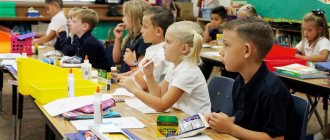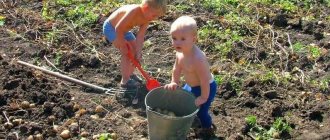Integration of the educational process in a preschool institution
Korotkova Svetlana
Integration of the educational process in a preschool institution
Integration of the educational process in a preschool institution
I. Introduction.
Currently, there is an intensive development of preschool education in different directions: interest in the personality of a preschool child and his uniqueness is increasing; qualitatively new requirements are imposed on the organization of the educational process aimed at the physical, social-personal, cognitive-speech and artistic-aesthetic development of the preschool child . The fundamental principle for the development of modern preschool education , proposed by the Federal state requirements for the structure of the basic general education program of preschool education, is the principle of integration of educational areas .
Integration as a principle covers a fairly large number of didactic and educational phenomena and has factors that ensure its broad influence on the theory and practice of preschool education .
Recently, special attention has been paid to the integration of educational preschool education , and this is not accidental. In my opinion, it is at the preschool level that the integration of educational areas into a single whole is most effective, since the preschooler perceives the world around him holistically, and for him there should be no boundaries between educational areas .
An integrated approach to learning is increasingly recognized as an urgent need for modern education . To break down barriers between educational fields , they are grouped around core concepts and topics. This allows us to examine this area from different angles and reveal relationships. With integration, educational areas interact, but at the same time remain independent and equal in content and structure. Thus , we are talking about integrated learning as a system that unites and connects knowledge into a single whole, on the basis of which a holistic perception of the world is formed in children . Research and practice show that an effective way to implement educational functions is to put forward general educational problems and their consistent solution in a system of interrelated activities of children in various areas. Integration in preschool education allows us to move from a local, isolated consideration of various phenomena of reality to their interconnected comprehensive study.
Taking into account the age characteristics of preschoolers, the integration of educational areas makes it possible to show the child the world in all its diversity with the involvement of scientific knowledge, literature, music, painting, theater, which contributes to the emotional development of the child’s personality and the formation of his creative thinking.
The introduction of an integration system, to a greater extent than traditional education, contributes to the education of an erudite person with a holistic worldview, the ability to independently systematize his existing knowledge and have an unconventional approach to solving problems.
The principle of integration is innovative and obliges preschool institutions to radically restructure educational activities in kindergarten on the basis of synthesis , unification of educational areas , which involves obtaining a holistic product that ensures the formation of integrative qualities of the personality of a preschool child and his harmonious entry into society.
II. From the history of the issue.
For the first time , interest in the problem of integration arose in the works . Kamensky wrote that a subject will be mastered if it is given a solid foundation, if this foundation is laid deeply, if everything that allows for difference is different in the most precise way , and everything that has a mutual connection is constantly connected. These provisions of the great teacher present the essence of the universal course of development of any large complex system in relation to a particular case, which is the child’s knowledge system that develops during the process .
In domestic pedagogy, the first attempt at a theoretical study of aspects of this problem was made, which revealed the psychological foundations of the relationship between various subjects.
Throughout the twentieth century, integration was used by teachers at different levels of education as a harmonious unification of various subjects, which made it possible to introduce integrity into the child’s knowledge of the world. Particular interest in the problem of integration appeared at the end of the 20th century. At the same time, the term “ integration ”
.
In preschool pedagogy, significant theoretical and practical material has been accumulated on the problem of the relationship between types of children's activities from the standpoint of complex and integrated approaches , so it considers integration as a deeper form of relationship, interpenetration of different contents of education for preschool children , covering all types of artistic and creative activities. However, integrated activities have not been specifically studied as a form of integrated education for preschoolers .
III. A new approach to organizing the educational process with preschoolers .
Currently, teachers and specialists in preschool institutions are faced with a completely different task - to develop not integrated classes through a synthesis of educational areas , but to offer a holistic integrative process educational will be harmoniously combined for a holistic perception of the world around them. This is a fundamentally new approach to preschool education .
The need to implement the principle of integration in preschool education lies in the very nature of thinking, dictated by the laws of higher nervous activity, the laws of psychology and physiology. The use of integration in preschool education is explained , first of all, by a biological phenomenon, which is characterized by intensive maturation of the body and the formation of the psyche: rapid physical development occurs.
To effectively organize the integration process in preschool education, it is necessary to highlight the system-forming factor of integration as a “working unit”
, which can be any component of the content
of preschool education , the qualitative characteristics of its participants. The main system-forming factor is educational areas .
FGT is divided into 10 educational areas ( “Health”
,
“Physical education”
,
“Cognition”
,
“Music”
,
“Work”
,
“Reading fiction”
,
“Communication”
,
“Safety” , “Artistic creativity”
,
“Socialization”
, which should not be implemented in
the educational activities of preschool educational institutions in pure form - their synthesis , integration , which will ensure qualitative and quantitative changes in the formation of the personality qualities of a preschooler . At the same time, you need to understand that educational areas are given integrity not so much by their unification as by the penetration of one area (or several)
into another.
The second system-forming factor is the integration of educational areas based on calendar and thematic planning, which determines the logical and substantive basis of the holistic educational process .
The third factor is the integration of the main types of activities of preschool : cognitive-research, labor, artistic-creative, communicative, motor. Activity as a psychological basis for integration is capable of uniting disparate components within itself and providing the necessary conditions for the emergence of a new educational product , in the creation of which both teachers and parents are involved. Adults pursue the main goal: to raise children as people who know how to think, to navigate well in everything that their environment, correctly assess the various situations they encounter in life, and make independent decisions. But they often rush to give the child a set of ready-made knowledge and judgments, which he absorbs like a sponge. However, does this always give the expected result? The practice of preschool education shows that the success of learning is influenced not only by the content of the material offered, but also by the form of its presentation, which can arouse interest and cognitive activity. Some scientists, when integrating various types of activities, propose to create synthetic activity blocks. Bogoyavlenskaya is developing a “creative field”
, which allows you to include the child in creative activities.
Other researchers propose modules as an integrator of different activities. As an integrator of all types of child activities in preschool education, it is appropriate to consider the game.
As a result of mastering integrative activities , the child develops holistic social and psychological formations , integrated methods of activity that are easily transferred from one sphere to another, an individual style of activity, the development of social experience, and the development of creative abilities.
The fourth system-forming factor can be considered the formation of integrative personality qualities , which are provided for by FGT as the final result of the educational activities of preschool educational institutions . At its core, personality is holistic and systemic. In the process of personal development, the child gradually gains independence as the ability for autonomous existence and social activity as the ability to create and maintain his relationships with the environment. The integral individuality of each individual is formed in the process of education , development and training.
In FGT, the lines of education are clearly distinguished: spiritual and moral, civic, patriotic, gender, as well as the education of a healthy, safe lifestyle . The Federal document also highlights unified educational processes aimed at raising a citizen who loves his people, his land, his homeland, and who is tolerant of the culture, traditions and customs of other peoples. In my work, I use various pedagogical situations, the solution of which allows children to demonstrate their civic position, for example:
“A new boy came to kindergarten; he speaks Russian poorly, because he came from another country. He wanted to meet the guys, but couldn't. What would you do if you were present at this?” In addition, FGT outlines the development lines of preschool : physical, social-personal, cognitive-speech, artistic-speech. There is no doubt that the integration of educational activities should take into account and ensure the processes of upbringing and development of a preschooler . In order to qualitatively implement integration into a preschool educational institution , it is necessary to identify forms of integration that will provide a synthesis of educational areas , the interrelation of various types of activities and the formation of integrative qualities of a preschooler’s personality in the process of education and development. The forms of the integrative process characterize the final product, which acquires new functions and new relationships between the teacher, student, and parents. Such forms in preschool educational institutions can be joint creative projects, holidays, experiments, excursions, role-playing games, which reflect children’s impressions of the environment, their knowledge, understanding of current events and phenomena. Introducing children to the concepts of “school”
,
“library”
,
“museum”
I conduct excursions, conversations, read fiction, where during the excursions I teach them
how to deal with the employees of these institutions . I try to interest and encourage children to ask questions about school life, about the importance of the library, museum, I organize joint activities between children, children and school teachers, children and library staff, and a tour guide.
The peculiarity of the organization of the integrative process in preschool educational institutions is such that all of the listed forms cannot be carried out in their pure form; the choice of a specific topic presupposes their integration . For example, the topic “Dear Mothers”
(senior
preschool age ) involves the choice of such
educational areas as : “Socialization”
,
“Communication”
,
“Cognition”
,
“Music”
,
“Labor”
,
“Artistic creativity”
,
“Reading fiction”
, as well as different types of activities: artistic - creative, gaming, reading, cognitive and research. A single organizational form can be a matinee or a holiday.
The integration of educational areas and activities can be represented in the form of technological maps. Such a map can help a teacher combine educational areas , design joint and independent activities of children, determine its content and final product.
When implementing an integrated approach, it is necessary to follow the following principle: the content of related areas involved as additions should not replace or displace the main content of the topic being studied. According to the Federal state requirements for the structure of the basic general education program of preschool education , integration is the fundamental principle of organizing the educational process in preschool educational institutions , which leads to:
-reducing the educational load on the child while maintaining the quality of education ;
- compliance with the norms for the duration of organized activities while condensing their content;
- will help avoid duplication of educational .
In my opinion, this form of work with preschool is the most acceptable, since it ensures the creation of an environment that reveals a whole range of child abilities that, as a rule, do not manifest themselves during traditional education. The principle of combining several educational areas is a dialogue on a given topic. The theme includes specific content, image , emotional state, moral and aesthetic meaning. The theme as a key phrase, a figurative-verbal symbol, runs through a series of lessons and allows educational areas to enter into dialogue.
The value of integration is great . It has a positive effect on the development of independence, cognitive activity and interests of preschool children .
Consequently, integration as a holistic phenomenon that unites educational areas , different types of activities, techniques and methods into a single system based on planning, acts in preschool education as the leading means of organizing the educational process , the leading form of which is joint activities with adults and independent activities of children.
Logical-mathematical games, which are my main pedagogical activity with children, as a synthesis of various spheres of human activity, contain potential opportunities. Teaching the beginnings of mathematics is currently given an important place. This is caused by a number of reasons: the abundance of information received by the child, increased attention to computerization, the desire to make the learning process more intensive , the desire of parents in this regard, as early as possible, to teach the child to recognize numbers, count, to solve problems. With the help of logical and mathematical games, I teach children to think independently, to use the acquired knowledge in various conditions in accordance with the task. Many games pose the task of rational use of existing knowledge in mental operations:
- find characteristic features in objects and phenomena of the surrounding world;
- compare, group, classify objects according to certain criteria, draw correct conclusions.
Logic games develop children's sensory abilities. The processes of sensation and perception underlie a child’s cognition of the environment. Speech also develops: the vocabulary is filled and activated, correct sound pronunciation is formed, coherent speech develops, the ability to correctly express one’s thoughts, the development of thinking and speech is solved in continuous connection, the ability to argue one’s beliefs develops, arguments. These games give children access to non-traditional sources of information, increase the efficiency of independent and group work, provide completely new opportunities for creativity, acquisition and consolidation of skills, and allow the implementation of fundamentally new forms and methods of teaching. To do this, I selected logical tasks and combined them into several blocks:
- seriation tasks, they involve building strict logical series - logical patterns (arithmetic, geometric sequence, etc.)
;
- tasks to find patterns in the arrangement of figures;
- tasks for the development of logical memory, a group of tasks focused mainly on visual memory with support for memorizing logical sequences;
- classification tasks, these tasks occupy one of the central places. Here are tasks such as "The Fourth Wheel"
, as well as tasks for correcting classification errors;
- attention tasks, these are tasks like: “Find 8-10 differences in similar images ”
,
“Find 2 identical squares”
,
“Decipher
the images ” .
Thus , logical-mathematical problems teach the child to compare, correct logical errors, and independently search for the correct solutions . Using analysis and synthesis, explore parts , draw conclusions about the whole and establish connections between parts of the whole. They help to form logical thinking and solve non-standard problems. Thanks to the integration of the content of educational areas, children learn about the diversity of the world and receive a lot of positive emotions from it.
Technologies for integrating educational areas
Similar processes of searching and developing interactive technologies for the development and training of interaction between teachers, parents and children are associated with the implementation and integration of other educational areas: “Social and communicative development”, “Language development”, “Cognitive development”, “Artistic and aesthetic development”. For example, technologies such as “Mobile Application Technology” and “Annotated Drawing Technology” are aimed at integrating the educational areas “Speech Development” and “Artistic and Aesthetic Development”, which arose on the basis of interactive teaching methods of the same name, into various situations of developing interaction between children and adults.
The mobile collage technique involves creating a special set: for example, on the theme “My yard”, “street”, “shop”, “city”, “village”, etc., figures of children and adults, birds and animals, attributes of the environment - for example, cars, traffic lights, bus stops, pedestrian crossings, etc., are drawn or cut out statically from magazines and presented dynamically, pasted on cardboard or laminated. They are then cut out, placed in a box and signed. Then, with their help, the child and adult can model and act out any situation related to the topic. It is important that both collective and individual histories can be captured simultaneously—essentially a chain structure.
However, an adult can introduce a “forbidden word” rule - you can use an image, but you cannot name it - you must use synonyms. Thus, conversion relationships, expressed mainly by verbs, are easily reproduced by actions with pictures (hears - speaks, shows - looks, asks - gives, gets sick - gets treated, etc.).
Moreover, by using and expressing actions with his character, an adult can involve the child in actions by analogy, but in a different communicative situation (“I’ll catch up with the bus: “Stop, stop!” And what will you do if you’re late?”). The method of syntactic prediction is used (“If you miss the bus, then ...” or “If you were going to miss the bus, then ...”, “Although you will miss the bus, but ...”, etc.), which allows you to “work out » all options for spatio-temporal relations in a changing situation, immediately model them and choose the best option. In addition, such work can be carried out with a whole group of children at once - the method used in a number of developmental situations related to play activities from different educational areas will have a communicative learning effect - the effect of educational technology.
Receiving annotated drawings will have the same effect. The simplest application: An adult draws and comments on his actions, and the child acts as someone who guesses the content of the drawing, recreating its details along with the details of the story, gradually becoming involved in the drawing process and exchanging roles with the adult.
O.P. Gavrilushkina describes a more complex option when working with a group of children: “I want to draw a picture of your walk. I'll draw it quickly, like I'm drawing with chalk, and you'll really tell me how you played. I will draw everyone, I will tell you about you, Sasha, and about you. Do you want to draw with me?” Then the teacher encourages the children to take communicative actions, which are immediately reflected in his drawing: “Ask him why...”, “Ask him where...”, “Ask Seryozha...”, “Tell...”, “Share the news with him, tell him.” …" etc.
The adult must supplement the children's answers, formulating them grammatically and spelling correctly, in logically complete sentences. Together with the teacher or after him, the children repeat the phrase under the guidance of the teacher. “Anechka, now you ask. Who do you want to speak with? Marina? Fine. Ask her what game she played." At this time, mini-situations appear on the board, describing the children’s behavior and games during the walk. The duration of such a commentary drawing is no more than 10 minutes, even for older groups.
Health-saving technologies
Today, the development and implementation of such technologies is largely due to the search for ways to improve the health-improving activities of kindergarten teachers. This is due not only to the increase in the number of children with functional health disorders and the attempts of society to counter the negative impact of socio-economic shocks and environmental disasters on the health of the younger generation. Rather, health activities today are becoming the basis for the integration of educational areas: in particular, according to federal requirements for the structure of the general education program of preschool education, we are talking about such educational areas as “cognition”, “safety”, “socialization”, etc. This principle of integration educational areas becomes the basis for the formation of an interdisciplinary approach to the implementation of health-improving activities in preschool institutions and the definition of health-saving technologies (HST) in education as a system of measures to preserve and strengthen the health of children, consisting of methods and techniques, complex ways of solving health-improving problems.
In particular, the classification of A. M. Sivtsova refers to the following types of health technologies used in modern kindergartens:
- technologies for preserving and promoting health: stretching, rhythmoplasty, dynamic pauses, motor and sports games, relaxation, finger exercises, eye exercises, breathing exercises, strengthening exercises, corrective exercises, orthopedic exercises.
- methods of teaching a healthy lifestyle: physical education, problem-oriented play and play therapy, communicative games, health education, self-massage, acupressure, biofeedback.
- correctional technologies: art therapy, musical influence technologies, fairy tale therapy, color therapy, behavior correction technologies, psycho-gymnastics, phonetic rhythms.
In addition, in practice, a distinction is made between technologies that promote health and technologies that shape health. Similar processes of searching and developing interactive technologies for the development and training of interaction between teachers, parents and children are associated with the implementation and integration of other educational areas: “Artistic creativity”, “Music”, “Socialization”, “Communication”, “Cognition”, “Reading fiction” literature”, etc. For example, technologies such as “Mobile Application Technology” and “Annotated Drawing Technology” are aimed at integrating the educational areas “Communication” and “Artistic Creativity”, which arose on the basis of interactive teaching methods of the same name, transferred to various situations of developmental interaction children and adults.
The mobile collage technique involves creating a special set: for example, on the theme “My yard”, “street”, “shop”, “city”, “village”, etc., figures of children and adults, birds and animals, attributes of the environment - for example, cars, traffic lights, bus stops, pedestrian crossings, etc. are drawn or cut out statically from magazines and presented dynamically, pasted onto cardboard or laminated. They are then cut out, placed in a box and signed. Then, with their help, the child and adult can model and act out any situation related to the topic. It is important that both the collective and individual stories can be brought together at the same time—essentially a chain structure.




